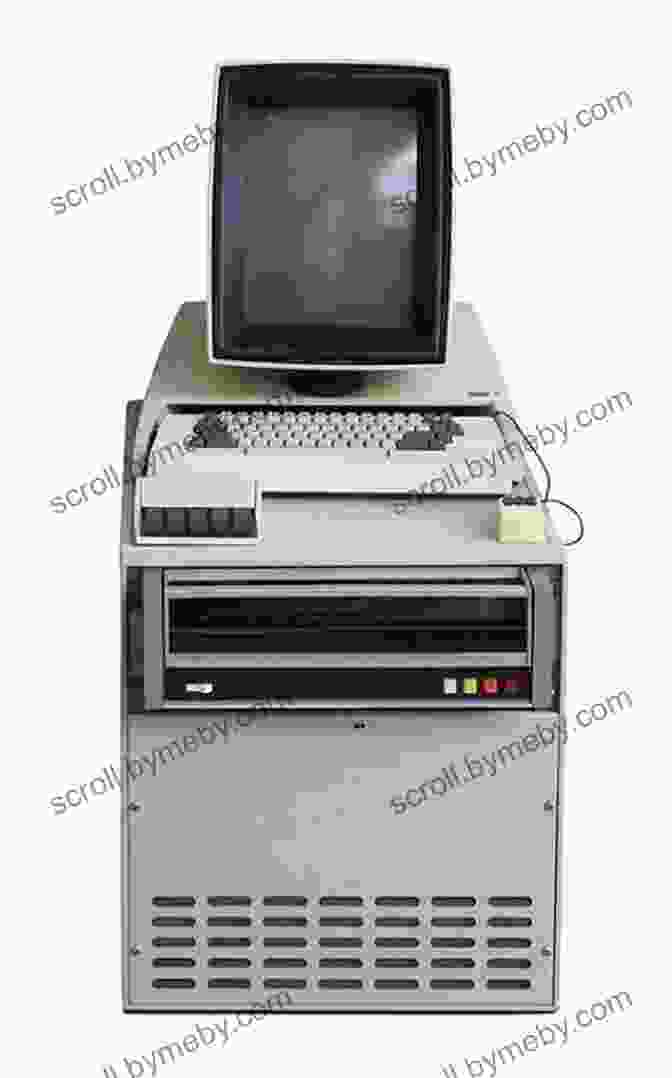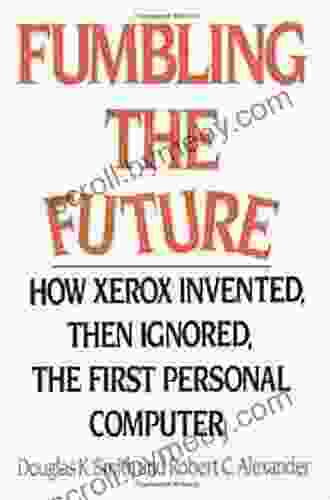How Xerox Invented Then Ignored the First Personal Computer: A Tale of Missed Opportunities

In the rapid evolution of modern technology, few stories are as intriguing as the rise and fall of Xerox and its role in the invention of the personal computer. It's a tale of brilliant minds, groundbreaking innovations, and a series of fateful decisions that ultimately allowed others to capitalize on their groundbreaking invention.
4.4 out of 5
| Language | : | English |
| File size | : | 492 KB |
| Text-to-Speech | : | Enabled |
| Screen Reader | : | Supported |
| Enhanced typesetting | : | Enabled |
| Word Wise | : | Enabled |
| Print length | : | 276 pages |
In the heart of Silicon Valley, during the late 1960s and early 1970s, Xerox's Palo Alto Research Center (PARC) was a hotbed of cutting-edge research and development. Within its walls, a team of brilliant engineers and scientists worked tirelessly, driven by a vision to create a more user-friendly and accessible way of interacting with computers.
Little did they know that their efforts would inadvertently give birth to one of the most transformative technologies of the modern age: the personal computer.
The Birth of the Alto
In 1973, Xerox PARC unveiled the Alto, widely regarded as the first true personal computer. It was a revolutionary device, featuring a graphical user interface (GUI),a mouse, and a built-in Ethernet connection. These groundbreaking features made the Alto incredibly user-friendly and laid the foundation for the personal computer revolution that was to follow.
The Alto was not without its flaws. It was bulky, expensive, and not particularly powerful by today's standards. However, its significance lies not in its technical specifications but in the seeds it sowed for future developments.

The Influence on Apple
In 1979, Steve Jobs and a team from Apple Inc. visited Xerox PARC and were given a demonstration of the Alto. Jobs was immediately captivated by the device's graphical interface and user-friendliness.
Inspired by what they saw at PARC, Jobs and his team went on to develop the Apple Lisa, which was released in 1983. The Lisa was the first commercially available personal computer with a GUI. Although it was not a commercial success, the Lisa paved the way for the groundbreaking Macintosh, released in 1984.
The Macintosh popularized the GUI and mouse-driven interface, making personal computers accessible to a wider audience. Apple's subsequent successes in the personal computer market are, in no small part, due to the innovations pioneered by Xerox PARC.
Xerox's Missed Opportunities
Despite inventing the first true personal computer, Xerox failed to capitalize on its groundbreaking invention. There are several reasons for this, including:
- Corporate culture: Xerox was primarily focused on its core business of photocopying and printing. The personal computer was seen as a potential distraction from this core business.
- Lack of vision: Xerox's management failed to fully grasp the potential of the personal computer and its implications for the future.
- Bureaucratic hurdles: Xerox's large size and bureaucratic structure made it difficult to bring new products to market quickly and efficiently.
As a result of these missed opportunities, Xerox allowed other companies, such as Apple and IBM, to take the lead in the personal computer market.
Legacy and Lessons Learned
The story of Xerox and the first personal computer is a cautionary tale about the importance of vision, innovation, and adaptability in business. It's a reminder that even the most groundbreaking inventions can be rendered obsolete if they are not properly nurtured and commercialized.
The legacy of Xerox's invention lives on in the countless personal computers that have shaped our world. From smartphones to laptops, the personal computer has become an indispensable tool for communication, productivity, and entertainment.
The lessons learned from Xerox's missed opportunities are valuable for businesses of all sizes:
- Embrace innovation and new ideas, even if they seem unconventional.
- Have a clear vision for the future of your business and be willing to invest in it.
- Be agile and adaptable to changing market conditions.
The story of Xerox and the first personal computer is a poignant reminder of the power of human ingenuity and the importance of seizing opportunities. It's a tale of missed opportunities, but also one of enduring legacy. The groundbreaking innovations pioneered by Xerox PARC continue to influence and shape our technological landscape to this day.
4.4 out of 5
| Language | : | English |
| File size | : | 492 KB |
| Text-to-Speech | : | Enabled |
| Screen Reader | : | Supported |
| Enhanced typesetting | : | Enabled |
| Word Wise | : | Enabled |
| Print length | : | 276 pages |
Do you want to contribute by writing guest posts on this blog?
Please contact us and send us a resume of previous articles that you have written.
 Book
Book Novel
Novel Page
Page Chapter
Chapter Text
Text Story
Story Genre
Genre Reader
Reader Library
Library Paperback
Paperback E-book
E-book Magazine
Magazine Newspaper
Newspaper Paragraph
Paragraph Sentence
Sentence Bookmark
Bookmark Shelf
Shelf Glossary
Glossary Bibliography
Bibliography Foreword
Foreword Preface
Preface Synopsis
Synopsis Annotation
Annotation Footnote
Footnote Manuscript
Manuscript Scroll
Scroll Codex
Codex Tome
Tome Bestseller
Bestseller Classics
Classics Library card
Library card Narrative
Narrative Biography
Biography Autobiography
Autobiography Memoir
Memoir Reference
Reference Encyclopedia
Encyclopedia Marcus Engel
Marcus Engel Constance Barker
Constance Barker Iris Bohnet
Iris Bohnet Collins O Onwe
Collins O Onwe Cynthia Li Md
Cynthia Li Md John Broome
John Broome Steven R Terrell
Steven R Terrell Lisa Preston
Lisa Preston Nina H Mitchell
Nina H Mitchell Trina Boice
Trina Boice Sean Iddings
Sean Iddings Henry Freeman
Henry Freeman Harold Holzer
Harold Holzer Timothy Hallinan
Timothy Hallinan Dagogo Altraide
Dagogo Altraide Grace Liu
Grace Liu Edward Jay Epstein
Edward Jay Epstein Ralf Ingo Jacob
Ralf Ingo Jacob Craig Seidelson
Craig Seidelson D A Mcgrath
D A Mcgrath
Light bulbAdvertise smarter! Our strategic ad space ensures maximum exposure. Reserve your spot today!

 Terence NelsonUnveiling the Enchanting World of "Believe Me": A Literary Journey into the...
Terence NelsonUnveiling the Enchanting World of "Believe Me": A Literary Journey into the...
 Julian PowellDiscover the Rhythms of Nature with Seasons of the Sacred Earth: A Journey...
Julian PowellDiscover the Rhythms of Nature with Seasons of the Sacred Earth: A Journey... Floyd RichardsonFollow ·13.4k
Floyd RichardsonFollow ·13.4k Jamie BlairFollow ·13.3k
Jamie BlairFollow ·13.3k Robert HeinleinFollow ·19.6k
Robert HeinleinFollow ·19.6k Francisco CoxFollow ·18.7k
Francisco CoxFollow ·18.7k Clinton ReedFollow ·9.5k
Clinton ReedFollow ·9.5k Fernando BellFollow ·16.7k
Fernando BellFollow ·16.7k Gabriel BlairFollow ·18k
Gabriel BlairFollow ·18k José SaramagoFollow ·18.4k
José SaramagoFollow ·18.4k

 Cruz Simmons
Cruz SimmonsUnveiling the Secrets: An Insider Guide to School Bonds...
Unlock the Power of School...

 Gil Turner
Gil TurnerRuins of Empire: Blood on the Stars - The Epic Space...
Ruins of Empire: Blood on the Stars is the...

 Allen Ginsberg
Allen GinsbergPrepare for the Ultimate Space Opera: Delve into The Last...
Embark on an...

 Anton Foster
Anton FosterUnleash Your Inner Artist: The Ultimate Guide to Oil...
Chapter 1: The...
4.4 out of 5
| Language | : | English |
| File size | : | 492 KB |
| Text-to-Speech | : | Enabled |
| Screen Reader | : | Supported |
| Enhanced typesetting | : | Enabled |
| Word Wise | : | Enabled |
| Print length | : | 276 pages |












